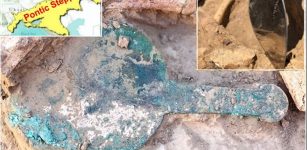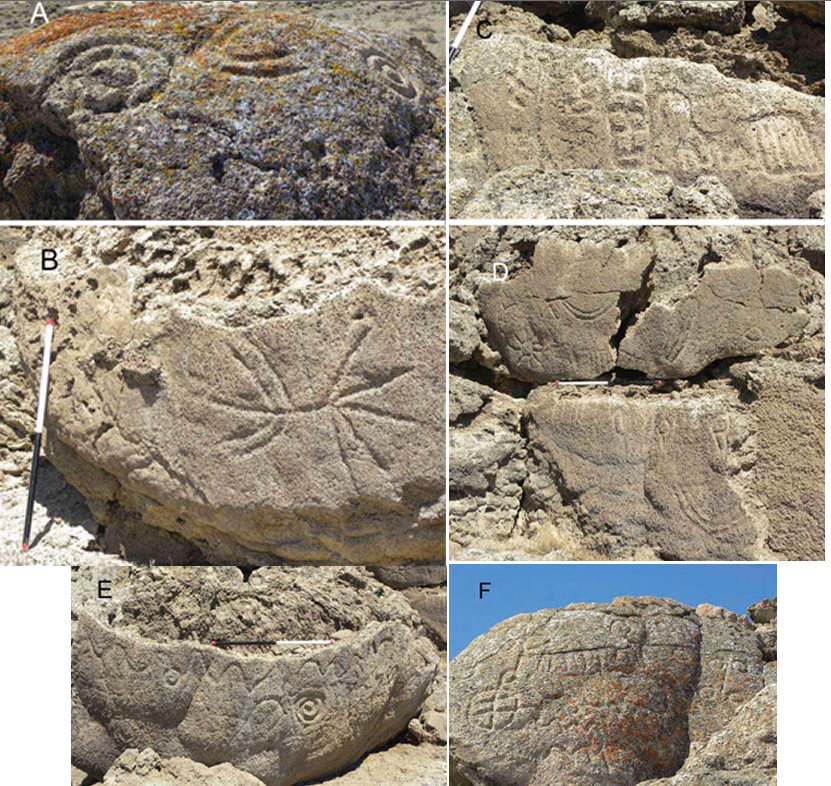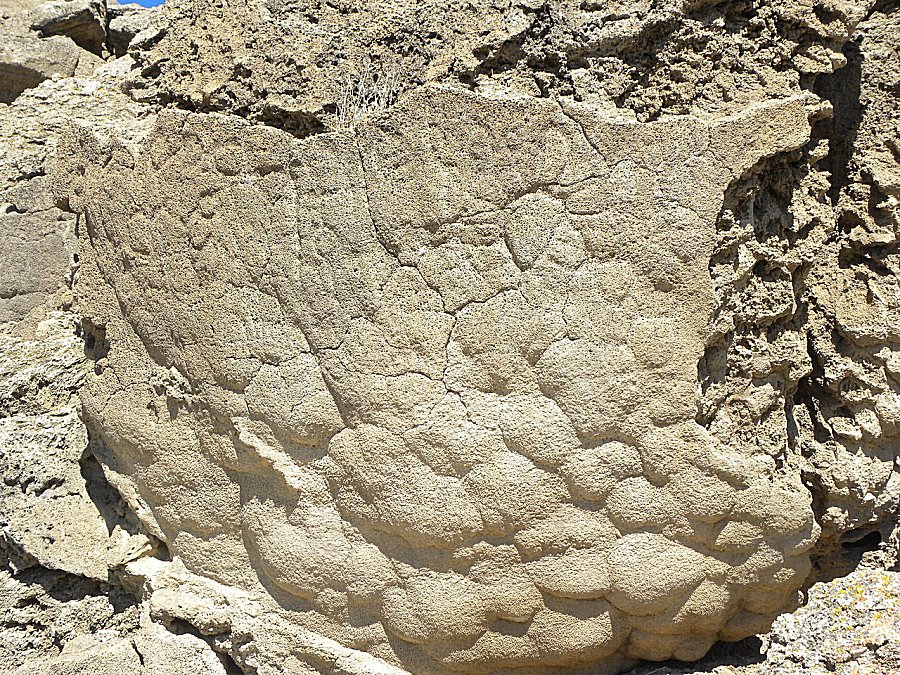Petroglyphs At The Winnemucca Lake: North America’s Oldest Known
A. Sutherland - AncientPages.com - North America’s petroglyphs at the Winnemucca Lake are the oldest known.
Cut into several boulders located within the Pyramid Lake Indian Reservation, in western Nevada, the petroglyphs date to at least 10,500 years ago and perhaps even as far back as 14,800 years ago.
The petroglyphs that have been known for several decades are located on the west side of Winnemucca Lake, 35 miles northeast of Reno, Nevada. Deeply carved, large grooves and dots form complex designs on several large limestone boulders. These designs are closely spaced, forming panels on boulder-sized surfaces of a partially collapsed tufa mound.
The rock art's designs also include a number of vertical, chain-like symbols and a series of smaller pits deeply incised with a type of hard rock scraper. However, a very interesting feature of the petroglyphs is that they do not depict humans, animals, or even handprint symbols.
 The oldest dates calculated for the Winnemucca Lake petroglyph site correspond with the time frame linked to several pieces of fossilized human excrement found in a cave in Oregon.
The oldest dates calculated for the Winnemucca Lake petroglyph site correspond with the time frame linked to several pieces of fossilized human excrement found in a cave in Oregon.
Several methods have been used to date these petroglyphs. At first, rock art was preliminarily described in 1992 as unusual, and possibly very early. Two years later, geochemist Larry Benson at the University of Colorado Museum of Natural History, determined the petroglyphs were carved into tufa, a type of limestone widespread over many places around the world but in the US especially concentrated near Pyramid Lake, Nevada, and Mono Lake, California.
The research showed that the limestone was deposited between 16,200 and 14,800 years ago, but no specific date for the carvings was suggested.
Winnemucca Lake, NV, USA. Petroglyphs were carved into the tufa structures by prehistoric Native Americans. Radiocarbon dating of tufa laysrs covering the petroglyphs in 2013 showed these to be the oldest known petroglyphs in the Americas. This image shows details of petroglyphs being covered by tufa layers later after the water level rose. Image credit: Larry V. Benson, USGS - https://dx.doi.org/10.1016/j.jas.2013.06.022.
Cut into several boulders in western Nevada, these petroglyphs date to at least 10,500 years ago and perhaps even as far back as 14,800 years ago.
The elevation was very important to the study. When the lake level was very high, the boulders were still submerged and not accessible for carving. The unknown ancient artists had to wait until the lake level was low enough to allow access to the rocks.
There was a time (12,600 to 11,400 years ago) when the water level was sufficiently low. Then it raised again and later, it had intermittent low periods thereafter.
So, when were the boulders covered with the petroglyphs?
Finally, it has been determined that the petroglyph rocks were above the waterline, and thus available for carving, from 14,800 and 13,200 years ago and between 11,300 and 10,500 years ago.
For now, the oldest known petroglyphs in North America date to at least 10,500 years ago and perhaps even as far back as 14,800 years ago.
How this rock art was created is not known. It is known, however, that there are only a few petroglyphs in the American Southwest that are as deeply carved as the petroglyphs at the Winnemucca Lake, and few that have the same size.
The rocks include both simple straight lines and swirls and more complex depictions that resemble flowers, trees, or the veins of a leaf. There also is an intricate diamond pattern on one rock. The smallest of the carvings are about 8 inches (20 cm) in width, while the largest is 3 feet (0.91 m). Grooves are approximately .4 to .8 inches (1.0 to 2.0 cm) deep.
The meaning of these petroglyphs cannot be determined with certainty, although some theories have proposed that they may represent clouds, lightning, or meteorological symbols.
The petroglyphs at the Winnemucca site still keep their ancient secrets.
Written by – A. Sutherland AncientPages.com Senior Staff Writer
Copyright © AncientPages.com All rights reserved. This material may not be published, broadcast, rewritten or redistributed in whole or part without the express written permission of AncientPages.com
Expand for referencesReferences:
"Dating North America's oldest petroglyphs, Winnemucca Lake subbasin, Nevada". Journal of Archaeological Science
More From Ancient Pages
-
 Why Is A Biscuit Named After Giuseppe Garibaldi – Italy’s Military Leader And Hero?
Ancient History Facts | Feb 19, 2017
Why Is A Biscuit Named After Giuseppe Garibaldi – Italy’s Military Leader And Hero?
Ancient History Facts | Feb 19, 2017 -
 Pacific God A’a: Fascinating Polynesian Sculpture Designed To Carry A Human Skull And Bones
Archaeology | Apr 9, 2016
Pacific God A’a: Fascinating Polynesian Sculpture Designed To Carry A Human Skull And Bones
Archaeology | Apr 9, 2016 -
 Thor And Tyr Journey To Hymir’s Hall To Steal Huge Cauldron – In Norse Mythology
Featured Stories | Jun 6, 2023
Thor And Tyr Journey To Hymir’s Hall To Steal Huge Cauldron – In Norse Mythology
Featured Stories | Jun 6, 2023 -
 Unique 1,300-Year-Old Pala Period Idol Of Snake Goddess, Nag Devi Discovered Near Nalanda University, India
Archaeology | Apr 5, 2022
Unique 1,300-Year-Old Pala Period Idol Of Snake Goddess, Nag Devi Discovered Near Nalanda University, India
Archaeology | Apr 5, 2022 -
 Bighorn Medicine Wheel: Sacred Site And Ancient Solar Observatory
Civilizations | May 29, 2016
Bighorn Medicine Wheel: Sacred Site And Ancient Solar Observatory
Civilizations | May 29, 2016 -
 Lost Ancient Texts Of The Star Catalogue Composed By The Greek Astronomer Hipparchus Found
News | Feb 21, 2023
Lost Ancient Texts Of The Star Catalogue Composed By The Greek Astronomer Hipparchus Found
News | Feb 21, 2023 -
 Streets Of Ancient Rome Were Very Dangerous
Ancient History Facts | Feb 29, 2016
Streets Of Ancient Rome Were Very Dangerous
Ancient History Facts | Feb 29, 2016 -
 Pre-Columbian People Of The Amazon Altered Their Landscape Thousands Of Years Earlier Than Previously Thought
Archaeology | Jun 14, 2021
Pre-Columbian People Of The Amazon Altered Their Landscape Thousands Of Years Earlier Than Previously Thought
Archaeology | Jun 14, 2021 -
 Cosmic Impact 12,800 Years Ago Forced Hunter-Gatherers In The Levant To Adopt Agricultural Practices
Archaeology | Oct 4, 2023
Cosmic Impact 12,800 Years Ago Forced Hunter-Gatherers In The Levant To Adopt Agricultural Practices
Archaeology | Oct 4, 2023 -
 Will Egypt be able to buy back the 4500-year-old statue of Sekhemka?
Artifacts | Aug 26, 2015
Will Egypt be able to buy back the 4500-year-old statue of Sekhemka?
Artifacts | Aug 26, 2015 -
 Scythians Were Not Always Nomadic Warriors Of The Pontic Steppe In Black Sea Region
Archaeology | Mar 19, 2021
Scythians Were Not Always Nomadic Warriors Of The Pontic Steppe In Black Sea Region
Archaeology | Mar 19, 2021 -
 Ouroboros: Ancient Infinity Symbol Used By Different Ancient Civilizations
Ancient Symbols | Oct 3, 2017
Ouroboros: Ancient Infinity Symbol Used By Different Ancient Civilizations
Ancient Symbols | Oct 3, 2017 -
 Samurai Swords: Katana And Wakizashi And Their Long Tradition
Ancient Traditions And Customs | Aug 6, 2018
Samurai Swords: Katana And Wakizashi And Their Long Tradition
Ancient Traditions And Customs | Aug 6, 2018 -
 Posca: ‘Wine Of The People’ Was Popular In Ancient Rome And Greece
Ancient History Facts | Sep 26, 2018
Posca: ‘Wine Of The People’ Was Popular In Ancient Rome And Greece
Ancient History Facts | Sep 26, 2018 -
 King Seqenenre Taa II Was Killed By Hyksos Invaders – Mummy Scans Reveal His Wounds
Archaeology | Feb 17, 2021
King Seqenenre Taa II Was Killed By Hyksos Invaders – Mummy Scans Reveal His Wounds
Archaeology | Feb 17, 2021 -
 Independent Invention: Iconic Native American Stone Tool Technology Discovered In Arabia
Archaeology | Aug 6, 2020
Independent Invention: Iconic Native American Stone Tool Technology Discovered In Arabia
Archaeology | Aug 6, 2020 -
 Tumlehed Rock Art And Seafaring In Stone Age’s Sweden
Archaeology | Nov 11, 2019
Tumlehed Rock Art And Seafaring In Stone Age’s Sweden
Archaeology | Nov 11, 2019 -
 Courageous Elizabeth Freeman – First African American Slave Who Filed A Freedom Suit
Featured Stories | Oct 24, 2018
Courageous Elizabeth Freeman – First African American Slave Who Filed A Freedom Suit
Featured Stories | Oct 24, 2018 -
 The Perplexing Story Of The Seven Continents And The Seven Mysterious Races – Can The Past Foretell The Future? – Part 2
Ancient Mysteries | May 15, 2022
The Perplexing Story Of The Seven Continents And The Seven Mysterious Races – Can The Past Foretell The Future? – Part 2
Ancient Mysteries | May 15, 2022 -
 Algonquin People And The Myth Of The Medicine Woman In The Moon
Featured Stories | Feb 1, 2016
Algonquin People And The Myth Of The Medicine Woman In The Moon
Featured Stories | Feb 1, 2016



